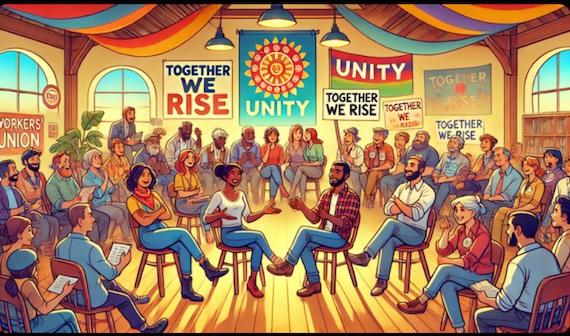Greenfield, Mass. (Special to Informed Comment, Feature) – My father was a family doctor in the mid-twentieth century whose main political issue was socialized medicine, which he preached against to his “large, poor family,” as he liked to describe us. Dad never turned away a patient who couldn’t pay and brought in indigent patients from his office to have dinner with us. Yet he couldn’t see the parallel between the security he offered patients and the security socialized medicine would have offered him and all of his patients.
My cousins on the other hand were truckdrivers and so is my brother-in-law; all were members of unions. Their unions saved them, being working class, with decent salaries, retirement benefits, and health packages. But that was before unions had the life sucked out of them by anti-union tactics such that, by 2022, union membership plummeted to 10.1% in the U.S. compared to 20.1% in 1983.
Today unions have suddenly diversified, in part because our workplace is more diverse, with more service workers and less manufacturing, but also because unions are being welcomed by the youngest generation, Gen Z, with an openness that is unprecedented.
Filing petitions is the first sign that people are working to unionize their workplace. Last year, 2024, saw union petitions jump 27% compared with 2023; and they more than doubled since 2021. Gen Z, those born since 1997 and after, is the most progressive and pro-union generation in the US. They approve of unions more than earlier generations at their ages, with a rating of 64.3%; and they have more diversity – women, people of color – and less class division than ever.
Whether coffee baristas, or hotel workers, or faculty unions their most important reasons for joining unions are better pay and benefits, employee representation, and job security. They are embracing multiple strategies, including “salting” a tactic in which a person takes a job in a workplace with the intention of organizing it.
Working from within rather from without, has its advantages: In Buffalo, NY, a team of 10 salts across Starbucks cafes was able to launch an effective campaign quick enough that Starbucks wasn’t able to launch their union busting tactics – essential to the salts’ win. You don’t have to get a job in an auto factory today to get your union experience; every job – tech, higher ed, media, hotel workers, and housekeeper – benefits from a democratizing union.
This resurgence of union organizing, activism and victories across the US is taking place even where least expected: at an 8,300-worker Amazon warehouse in NYC and at Microsoft whose 600 workers at Activision game subsidiary pulled off a union victory. Every indicator is flashing: the number of workers involved in major strikes; the number of union petitions; and the “win vote for union elections has risen.” They have confounded workplace experts who predicted that labor was dying, while suddenly they are rising like a phoenix with renewed energy and support.
Polls are showing that American approve of unions at the highest level in more than half a century, and 88% of those under 30 years view them favorably: no wonder the surge of unionization in Starbucks, Amazon, Trader Joe’s, video game companies, Barnes and Nobles, universities, museums.
Their results have paid off: raises won by United Auto Workers in Detroit topped all the raises over the last 20 years. Ten thousand hotel workers at 34 Southern California hotels won raises which translate to 40% to 50% pay hikes over four years and will raise wages to $35 as hour.

“Union Unity,” Digital, ChatGPT, 2024.
In the 1950s, more than 1 in 3 workers belonged to a union (and they enjoyed the highest rate of approval, 75%) but that rate fell over the decades to 1 in 16 private–sector workers. Today’s numbers are the lowest rate of unionization since the early 1930s before the National Labor Relations Action (NLRA), a law that gave private sector workers a federal right to unionize. The recent wins at Starbucks and Amazon, both fiercely anti-union companies, have been a shot of adrenaline in the arm for the new union movement-something sociologists call the contagion effect.
So, too, the recent law in California which bans mandatory anti-union meetings in workplaces. For decades workers were forced to attend meetings called “captive-audience” meetings during work shifts in which they listened to their employers tell them why they don’t want them to unionize, despite federal labor laws saying they should be free to choose. The
Economic Policy Institute has found that nearly 90% of employers have used captive-audience meetings to deter unionization efforts, spending “more than $400 million a year” and using extremely intimidating tactics. California joins 11 other states with bans on mandatory anti-union meetings and six more state proposals are in the works.
“Democrats (and Independents) must find [our] inner populists and fight at all times even in battles that they will almost certainly lose.” Unions are showing the way.


 © 2025 All Rights Reserved
© 2025 All Rights Reserved